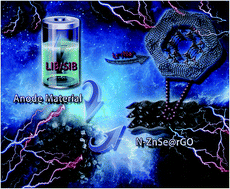MOF-derived and nitrogen-doped ZnSe polyhedra encapsulated by reduced graphene oxide as the anode for lithium and sodium storage†
Abstract
Transition metal chalcogenides (TMCs) reveal a bright prospect as high-performance electrode materials for lithium ion batteries (LIBs) and sodium ion batteries (SIBs). In this work, ZIF-8 derived nitrogen-doped ZnSe (N-ZnSe) polyhedra encapsulated by reduced graphene oxide (rGO) composites have been successfully fabricated via a carbonization–selenylation procedure. The optimized N-ZnSe@rGO delivers an ultrahigh capacity (836 mA h g−1 at 100 mA g−1) and displays ultrahigh stability (464 mA h g−1 at 2000 mA g−1 after 1000 cycles) as the anode in LIBs, while it shows a reversible capacity of 285 mA h g−1 after 500 cycles at 300 mA g−1 for SIBs. The unique N-doped ZnSe polyhedra can enhance the number of active sites for electrons and promote the conductivity of the active materials. Furthermore, the wrapped rGO networks can provide enough surface area and offer a conductive matrix to enhance charge transfer kinetics, preventing ZnSe from pulverizing and aggregating. The synthetic method can be extended to other MOF-based TMCs as Li/Na-storage anode materials.



 Please wait while we load your content...
Please wait while we load your content...